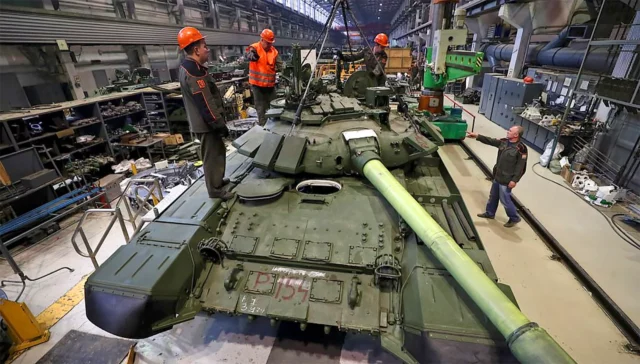
The Kremlin’s Economic Mobilization
Publication: Eurasia Daily Monitor Volume: 19 Issue: 161
By:

Following the “partial mobilization” of the Russian populace, huge losses in arms, as well as economic and budgetary imbalances, Moscow is facing the inevitable prospect of a complete economic mobilization. Since October 19, martial law has been implemented in the occupied and formally annexed Ukrainian territories, except Crimea (Kremlin.ru, October 19), and the different regimes have been established for the possible implementation of martial law and economic mobilization in other Russian regions and annexed Crimea (Kremlin.ru, October 19). Simultaneously, Moscow Mayor Sergey Sobyanin, as the head of the Russian State Council’s commission on state and local governance has become responsible for coordinating the various regional efforts in executing these orders (TASS, October 19).
Two days later, on October 21, the Kremlin established the Government Coordination Council for the express purpose of supplying the Russian Armed Forces and other military branches with necessary equipment, especially for the recently mobilized recruits. Russian Prime Minister Mikhail Mishustin was named the head of the council; other members of the council include several government officials responsible for economic development and finances together with Russian Minister of Defense Sergei Shoigu, the various heads of the law enforcement agencies and Sobyanin (Kremlin.ru, October 21). However, after one week of existence, the council has yet to make any major decisions (Government.ru, October 24). And according to Sobyanin’s presentation, the only significant result has been arranging accommodations for 60,000 newly mobilized soldiers, which again testifies to the fact that the Kremlin is far from mobilizing the announced goal of 300,000 soldiers (Kremlin.ru, October 25). The various Russian regions also have not demonstrated any significant activity related to the impending economic mobilization and probable declaration of martial law.
Even so, all this activity means that the Kremlin is trying to mobilize the civil bureaucracy and restore a command economic system in the hopes of consolidating the Russian political system, as well as repairing and replacing at least some of the huge losses suffered in Ukraine.
One major reason for these efforts is a mobilization of the civil bureaucracy itself at both the governmental and regional levels. To date, the war has compromised most of the previous plans and programs that were introduced by Moscow and the regional authorities before February 24. Overall, the lack of actual planning coupled with the demoralization of public officials has paralyzed civil governance. And a lack of demonstrative loyalty and political submission within Russian society have further impeded the Kremlin’s plans.
Russian President Vladimir Putin, his inner circle and the heads of the military and security services appear to be the main individuals directly responsible for the aggression against Ukraine, while the government, governors and regional elites pretend they will survive the turbulence. In truth, the Kremlin’s aim is to make this impossible for them and to share responsibility for the war and future unpopular decisions with them, including the next waves of mobilization and the inevitable economic mobilization.
The Russian leadership still denies that crucial troubles, such as lack of key arms and other essential military equipment, are plaguing Russian forces. For example, even Dmitry Medvedev, who is not a member of the new coordination council, regularly inspects the defense factories around Russia and threatens managers and workers with criminal liability if they fail to supply urgent arms in adequate amounts (TASS, October 24).
This fact is illustrated by a telling example: The 103th Armored Repair Plant received a three-year contract for a complete overhaul of 800 T-62 battle tanks, which were developed in the late 1950s and finally decommissioned by the Russian army soon after the war against Georgia in 2008 (Kommersant, October 12); it is doubtful that the plant will be able to complete the contract due to a lack of qualified personnel and technical backwardness (Chita.ru, December 13, 2021; October 5). Therefore, the bet on the T-62s reveals a deficit of T-72, T-80 and T-90 tanks, as well as the extensive troubles in manufacturing a new generation of the T-14 Armata battle tank.
Outside of tanks, even the issue of shortages in uniforms and other essential equipment appears to be a constant problem for Russian units, which must be solved at the level of Mishustin himself and the Governmental Coordination Council (Kremlin.ru, October 25).
Generally speaking, the Russian authorities are trying to increase arms manufacturing without totally destroying the fragile balance of the Russian economy. They realized this challenge as early as this summer but still have not produced any definitive, or effective, decisions. The main vector here is direct state governance in key economic industries while keeping market residuals at the more grassroots levels of consumer goods manufacturing, retail and services (Interfax-AVN, August 15). The problem is that the Russian defense industry will not be able to supply all the necessary goods to the Russian Armed Forces, and the Kremlin will inevitably try to force the private sector and Russian citizens to pay directly for military supplies. In this way, the further repression of society and increasing self-isolation from the world will become the only option for Russia if it continues to wage this war.



